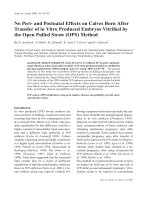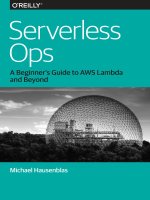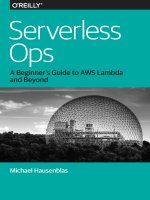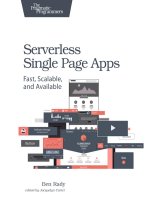serverless ops
Bạn đang xem bản rút gọn của tài liệu. Xem và tải ngay bản đầy đủ của tài liệu tại đây (6.29 MB, 48 trang )
O’Reilly Web Ops
Serverless Ops
A Beginner’s Guide to AWS Lambda and Beyond
Michael Hausenblas
Serverless Ops
by Michael Hausenblas
Copyright © 2017 O’Reilly Media, Inc. All rights reserved.
Printed in the United States of America.
Published by O’Reilly Media, Inc., 1005 Gravenstein Highway North, Sebastopol, CA 95472.
O’Reilly books may be purchased for educational, business, or sales promotional use. Online
editions are also available for most titles (). For more information,
contact our corporate/institutional sales department: 800-998-9938 or
Editor: Virginia Wilson
Acquisitions Editor: Brian Anderson
Production Editor: Shiny Kalapurakkel
Copyeditor: Amanda Kersey
Proofreader: Rachel Head
Interior Designer: David Futato
Cover Designer: Karen Montgomery
Illustrator: Rebecca Panzer
November 2016: First Edition
Revision History for the First Edition
2016-11-09: First Release
The O’Reilly logo is a registered trademark of O’Reilly Media, Inc. Serverless Ops, the cover image,
and related trade dress are trademarks of O’Reilly Media, Inc.
While the publisher and the author have used good faith efforts to ensure that the information and
instructions contained in this work are accurate, the publisher and the author disclaim all
responsibility for errors or omissions, including without limitation responsibility for damages
resulting from the use of or reliance on this work. Use of the information and instructions contained in
this work is at your own risk. If any code samples or other technology this work contains or describes
is subject to open source licenses or the intellectual property rights of others, it is your responsibility
to ensure that your use thereof complies with such licenses and/or rights.
978-1-491-97079-9
[LSI]
Preface
The dominant way we deployed and ran applications over the past decade was machine-centric.
First, we provisioned physical machines and installed our software on them. Then, to address the low
utilization and accelerate the roll-out process, came the age of virtualization. With the emergence of
the public cloud, the offerings became more diverse: Infrastructure as a Service (IaaS), again
machine-centric; Platform as a Service (PaaS), the first attempt to escape the machine-centric
paradigm; and Software as a Service (SaaS), the so far (commercially) most successful offering,
operating on a high level of abstraction but offering little control over what is going on.
Over the past couple of years we’ve also encountered some developments that changed the way we
think about running applications and infrastructure as such: the microservices architecture, leading to
small-scoped and loosely coupled distributed systems; and the world of containers, providing
application-level dependency management in either on-premises or cloud environments.
With the advent of DevOps thinking in the form of Michael T. Nygard’s Release It! (Pragmatic
Programmers) and the twelve-factor manifesto, we’ve witnessed the transition to immutable
infrastructure and the need for organizations to encourage and enable developers and ops folks to
work much more closely together, in an automated fashion and with mutual understanding of the
motivations and incentives.
In 2016 we started to see the serverless paradigm going mainstream. Starting with the AWS Lambda
announcement in 2014, every major cloud player has now introduced such offerings, in addition to
many new players like OpenLambda or Galactic Fog specializing in this space.
Before we dive in, one comment and disclaimer on the term “serverless” itself: catchy as it is, the
name is admittedly a misnomer and has attracted a fair amount of criticism, including from people
such as AWS CTO Werner Vogels. It is as misleading as “NoSQL” because it defines the concept in
terms of what it is not about.1 There have been a number of attempts to rename it; for example, to
Function as a Service(FaaS). Unfortunately, it seems we’re stuck with the term because it has gained
traction, and the majority of people interested in the paradigm don’t seem to have a problem with it.
You and Me
My hope is that this report will be useful for people who are interested in going serverless, people
who’ve just started doing serverless computing, and people who have some experience and are
seeking guidance on how to get the maximum value out of it. Notably, the report targets:
DevOps folks who are exploring serverless computing and want to get a quick overview of the
space and its options, and more specifically novice developers and operators of AWS Lambda
Hands-on software architects who are about to migrate existing workloads to serverless
environments or want to apply the paradigm in a new project
This report aims to provide an overview of and introduction to the serverless paradigm, along with
best-practice recommendations, rather than concrete implementation details for offerings (other than
exemplary cases). I assume that you have a basic familiarity with operations concepts (such as
deployment strategies, monitoring, and logging), as well as general knowledge about public cloud
offerings.
Note that true coverage of serverless operations would require a book with many more pages. As
such, we will be covering mostly techniques related to AWS Lambda to satisfy curiosity about this
emerging technology and provide useful patterns for the infrastructure team that administers these
architectures.
As for my background: I’m a developer advocate at Mesosphere working on DC/OS, a distributed
operating system for both containerized workloads and elastic data pipelines. I started to dive into
serverless offerings in early 2015, doing proofs of concepts, speaking and writing about the topic, as
well as helping with the onboarding of serverless offerings onto DC/OS.
Acknowledgments
I’d like to thank Charity Majors for sharing her insights around operations, DevOps, and how
developers can get better at operations. Her talks and articles have shaped my understanding of both
the technical and organizational aspects of the operations space.
The technical reviewers of this report deserve special thanks too. Eric Windisch (IOpipe, Inc.),
Aleksander Slominski (IBM), and Brad Futch (Galactic Fog) haven taken out time of their busy
schedules to provide very valuable feedback and certainly shaped it a lot. I owe you all big time (next
Velocity conference?).
A number of good folks have supplied me with examples and references and have written timely
articles that served as brain food: to Bridget Kromhout, Paul Johnston, and Rotem Tamir, thank you
so much for all your input.
A big thank you to the O’Reilly folks who looked after me, providing guidance and managing the
process so smoothly: Virginia Wilson and Brian Anderson, you rock!
Last but certainly not least, my deepest gratitude to my awesome family: our sunshine artist Saphira,
our sporty girl Ranya, our son Iannis aka “the Magic rower,” and my ever-supportive wife Anneliese.
Couldn’t have done this without you, and the cottage is my second-favorite place when I’m at home. ;)
1 The
term NoSQL suggests it’s somewhat anti-SQL, but it’s not about the SQL language itself.
Instead, it’s about the fact that relational databases didn’t use to do auto-sharding and hence were not
easy or able to be used out of the box in a distributed setting (that is, in cluster mode).
Chapter 1. Overview
Before we get into the inner workings and challenges of serverless computing, or Function as a
Service (FaaS), we will first have a look at where it sits in the spectrum of computing paradigms,
comparing it with traditional three-tier apps, microservices, and Platform as a Service (PaaS)
solutions. We then turn our attention to the concept of serverless computing; that is, dynamically
allocated resources for event-driven function execution.
A Spectrum of Computing Paradigms
The basic idea behind serverless computing is to make the unit of computation a function. This
effectively provides you with a lightweight and dynamically scalable computing environment with a
certain degree of control. What do I mean by this? To start, let’s have a look at the spectrum of
computing paradigms and some examples in each area, as depicted in Figure 1-1.
Figure 1-1. A spectrum of compute paradigms
In a monolithic application, the unit of computation is usually a machine (bare-metal or virtual). With
microservices we often find containerization, shifting the focus to a more fine-grained but still
machine-centric unit of computing. A PaaS offers an environment that includes a collection of APIs
and objects (such as job control or storage), essentially eliminating the machine from the picture. The
serverless paradigm takes that a step further: the unit of computation is now a single function whose
lifecycle you manage, combining many of these functions to build an application.
Looking at some (from an ops perspective), relevant dimensions further sheds light on what the
different paradigms bring to the table:
Agility
In the case of a monolith, the time required to roll out new features into production is usually
measured in months; serverless environments allow much more rapid deployments.
Control
With the machine-centric paradigms, you have a great level of control over the environment. You
can set up the machines to your liking, providing exactly what you need for your workload (think
libraries, security patches, and networking setup). On the other hand, PaaS and serverless
solutions offer little control: the service provider decides how things are set up. The flip side of
control is maintenance: with serverless implementations, you essentially outsource the
maintenance efforts to the service provider, while with machine-centric approaches the onus is on
you. In addition, since autoscaling of functions is typically supported, you have to do less
engineering yourself.
Cost per unit
For many folks, this might be the most attractive aspect of serverless offerings—you only pay for
the actual computation. Gone are the days of provisioning for peak load only to experience low
resource utilization most of the time. Further, A/B testing is trivial, since you can easily deploy
multiple versions of a function without paying the overhead of unused resources.
The Concept of Serverless Computing
With this high-level introduction to serverless computing in the context of the computing paradigms
out of the way, we now move on to its core tenents.
At its core, serverless computing is event-driven, as shown in Figure 1-2.
Figure 1-2. The concept of serverless compute
In general, the main components and actors you will find in serverless offerings are:1
Management interfaces
Register, upgrade, and control functions via web UIs, command-line interfaces, or HTTP APIs.
Triggers
Define when a function is invoked, usually through (external) events, and are scheduled to be
executed at a specific time.
Integration points
Support control and data transfer from function-external systems such as storage.
So, the serverless paradigm boils down to reacting to events by executing code that has been
uploaded and configured beforehand.
HOW SERVERLESS IS DIFFERENT FROM PAAS
Quite often, when people start to dig into serverless computing, I hear questions like “How is this
different from PaaS?”
Serverless computing (or FaaS), refers to the idea of dynamically allocating resources for an
event-driven function execution. A number of related paradigms and technologies exist that you
may have come across already. This sidebar aims to compare and delimit them.
PaaS shares a lot with the serverless paradigm, such as no provisioning of machines and
autoscaling. However, the unit of computation is much smaller in the latter. Serverless computing
is also job-oriented rather than application-oriented. For more on this topic, see Carl Osipov’s
blog post “Is Serverless Computing Any Different from Cloud Foundry, OpenShift, Heroku, and
Other Traditional PaaSes?”.
The Remote Procedure Call (RPC) protocol is all about the illusion that one can call a remotely
executed function (potentially on a different machine) in the same way as a locally executed
function (in the same memory space).
Stored procedures have things in common with serverless computing (including some of the
drawbacks, such as lock-in), but they’re database-specific and not a general-purpose computing
paradigm.
Microservices are not a technology but an architecture and can, among other things, be
implemented with serverless offerings.
Containers are typically the basic building blocks used by serverless offering providers to enable
rapid provisioning and isolation.
Conclusion
Conclusion
In this chapter we have introduced serverless computing as an event-driven function execution
paradigm with its three main components: the triggers that define when a function is executed, the
management interfaces that register and configure functions, and integration points that interact with
external systems (especially storage). Now we’ll take a deeper look at the concrete offerings in this
space.
1 I’ve
deliberately left routing (mapping, for example, an HTTP API to events) out of the core tenents
since different offerings have different approaches for how to achieve this.
Chapter 2. The Ecosystem
In this chapter we will explore the current serverless computing offerings and the wider ecosystem.
We’ll also try to determine whether serverless computing only makes sense in the context of a public
cloud setting or if operating and/or rolling out a serverless offering on-premises also makes sense.
Overview
Many of the serverless offerings at the time of writing of this report (mid-2016) are rather new, and
the space is growing quickly.
Table 2-1 gives a brief comparison of the main players. More detailed breakdowns are provided in
the following sections.
Table 2-1. Serverless offerings by company
Offering
Cloud offering On-premises Launched Environments
AWS Lambda
Yes
No
2014
Node.js, Python, Java
Azure Functions
Yes
Yes
2016
C#, Node.js, Python, F#, PHP, Java
Google Cloud Functions Yes
No
2016
JavaScript
iron.io
No
Yes
2012
Ruby, PHP, Python, Java, Node.js, Go, .NET
Galactic Fog’s Gestalt
No
Yes
2016
Java, Scala, JavaScript, .NET
IBM OpenWhisk
Yes
Yes
2014
Node.js, Swift
Note that by cloud offering, I mean that there’s a managed offering in one of the public clouds
available, typically with a pay-as-you-go model attached.
AWS Lambda
Introduced in 2014 in an AWS re:Invent keynote, AWS Lambda is the incumbent in the serverless
space and makes up an ecosystem in its own right, including frameworks and tooling on top of it, built
by folks outside of Amazon. Interestingly, the motivation to introduce Lambda originated in
observations of EC2 usage: the AWS team noticed that increasingly event-driven workloads were
being deployed, such as infrastructure tasks (log analytics) or batch processing jobs (image
manipulation and the like). AWS Lambda started out with support for the Node runtime and currently
supports Node.js 4.3, Python 2.7, and Java 8.
The main building blocks of AWS Lambda are:
The AWS Lambda Web UI (see Figure 2-1) and CLI itself to register, execute, and manage
functions
Event triggers, including, but not limited to, events from S3, SNS, and CloudFormation to trigger
the execution of a function
CloudWatch for logging and monitoring
Figure 2-1. AWS Lambda dashboard
Pricing
Pricing of AWS Lambda is based on the total number of requests as well as execution time. The first
1 million requests per month are free; after that, it’s $0.20 per 1 million requests. In addition, the free
tier includes 400,000 GB-seconds of computation time per month. The minimal duration you’ll be
billed for is 100 ms, and the actual costs are determined by the amount of RAM you allocate to your
function (with a minimum of 128 MB).
Availability
Lambda has been available since 2014 and is a public cloud–only offering.
We will have a closer look at the AWS Lambda offering in Chapter 4, where we will walk through an
example from end to end.
Azure Functions
During the Build 2016 conference Microsoft released Azure Functions, supporting functions written
with C#, Node.js, Python, F#, PHP, batch, bash, Java, or any executable. The Functions runtime is
open source and integrates with Azure-internal and -external services such as Azure Event Hubs,
Azure Service Bus, Azure Storage, and GitHub webhooks. The Azure Functions portal, depicted in
Figure 2-2, comes with templates and monitoring capabilities.
Figure 2-2. Azure Functions portal
As an aside, Microsoft also offers other serverless solutions such as Azure Web Jobs and Microsoft
Flow (an “if this, then that” [IFTTT] for business competitors).
Pricing
Pricing of Azure Functions is similar to that of AWS Lambda; you pay based on code execution time
and number of executions, at a rate of $0.000008 per GB-second and $0.20 per 1 million executions.
As with Lambda, the free tier includes 400,000 GB-seconds and 1 million executions.
Availability
Since early 2016, the Azure Functions service has been available both as a public cloud offering and
on-premises as part of the Azure Stack.
Google Cloud Functions
Google Cloud Functions can be triggered by messages on a Cloud Pub/Sub topic or through mutation
events on a Cloud Storage bucket (such as “bucket is created”). For now, the service only supports
Node.js as the runtime environment. Using Cloud Source Repositories, you can deploy Cloud
Functions directly from your GitHub or Bitbucket repository without needing to upload code or
manage versions yourself. Logs emitted are automatically written to Stackdriver Logging and
performance telemetry is recorded in Stackdriver Monitoring.
Figure 2-3 shows the Google Cloud Functions view in the Google Cloud console. Here you can
create a function, including defining a trigger and source code handling.
Figure 2-3. Google Cloud Functions
Pricing
Since the Google Cloud Functions service is in Alpha, no pricing has been disclosed yet. However,
we can assume that it will be priced competitively with the incumbent, AWS Lambda.
Availability
Google introduced Cloud Functions in February 2016. At the time of writing, it’s in Alpha status with
access on a per-request basis and is a public cloud–only offering.
Iron.io
Iron.io has supported serverless concepts and frameworks since 2012. Some of the early offerings,
such as IronQueue, IronWorker, and IronCache, encouraged developers to bring their code and run it
in the Iron.io-managed platform hosted in the public cloud. Written in Go, Iron.io recently embraced
Docker and integrated the existing services to offer a cohesive microservices platform. Codenamed
Project Kratos, the serverless computing framework from Iron.io aims to bring AWS Lambda to
enterprises without the vendor lock-in.
In Figure 2-4, the overall Iron.io architecture is depicted: notice the use of containers and container
images.
Figure 2-4. Iron.io architecture
Pricing
No public plans are available, but you can use the offering via a number of deployment options,
including Microsoft Azure and DC/OS.
Availability
Iron.io has offered its services since 2012, with a recent update around containers and supported
environments.
Galactic Fog’s Gestalt
Gestalt (see Figure 2-5) is a serverless offering that bundles containers with security and data
features, allowing developers to write and deploy microservices on-premises or in the cloud.
Figure 2-5. Gestalt Lambda
Pricing
No public plans are available.
Availability
Launched in mid-2016, the Gestalt Framework is deployed using DC/OS and is suitable for cloud and
on-premises deployments; no hosted service is available yet.
See the MesosCon 2016 talk “Lamba Application Servers on Mesos” by Brad Futch for details on the
current state as well as the upcoming rewrite of Gestalt Lambda called LASER.
IBM OpenWhisk
IBM OpenWhisk is an open source alternative to AWS Lambda. As well as supporting Node.js,
OpenWhisk can run snippets written in Swift. You can install it on your local machine running
Ubuntu. The service is integrated with IBM Bluemix, the PaaS environment powered by Cloud
Foundry. Apart from invoking Bluemix services, the framework can be integrated with any third-party
service that supports webhooks. Developers can use a CLI to target the OpenWhisk framework.
Figure 2-6shows the high-level architecture of OpenWhisk, including the trigger, management, and
integration point options.
Figure 2-6. OpenWhisk architecture
Pricing
The costs are determined based on Bluemix, at a rate of $0.0288 per GB-hour of RAM and $2.06 per
public IP address. The free tier includes 365 GB-hours of RAM, 2 public IP addresses, and 20 GB of
external storage.
Availability
Since 2014, OpenWhisk has been available as a hosted service via Bluemix and for on-premises
deployments with Bluemix as a dependency.
See “OpenWhisk: a world first in open serverless architecture?” for more details on the offering.
Other Players
In the past few years, the serverless space has seen quite some uptake, not only in terms of end users
but also in terms of providers. Some of the new offerings are open source, some leverage or extend
existing offerings, and some are specialized offerings from existing providers. They include:
OpenLambda, an open source serverless computing platform
Nano Lambda, an automated computing service that runs and scales your microservices
Webtask by Auth0, a serverless environment supporting Node.js with a focus on security
Serverless Framework, an application framework for building web, mobile, and Internet of Things
(IoT) applications powered by AWS Lambda and AWS API Gateway, with plans to support other
providers, such as Azure and Google Cloud
IOpipe, an analytics and distributed tracing service that allows you to see inside AWS Lambda
functions for better insights into the daily operations
Cloud or on-Premises?
A question that often arises is whether serverless computing only makes sense in the context of a
public cloud setting, or if rolling out a serverless offering on-premises also makes sense. To answer
this question, we will discuss elasticity features, as well as dependencies introduced when using a
serverless offering.
So, which one is the better option? A public cloud offering such as AWS Lambda, or one of the
existing open source projects, or your home-grown solution on-premises? As with any IT question,
the answer depends on many things, but let’s have a look at a number of considerations that have been
brought up in the community and may be deciding factors for you and your organization.
One big factor that speaks for using one of the (commercial) public cloud offerings is the ecosystem.
Look at the supported events (triggers) as well as the integrations with other services, such as S3,
Azure SQL Database, and monitoring and security features. Given that the serverless offering is just
one tool in your toolbelt, and you might already be using one or more offerings from a certain cloud
provider, the ecosystem is an important point to consider.
Oftentimes the argument is put forward that true autoscaling of the functions only applies to public
cloud offerings. While this is not black and white, there is a certain point to this claim: the elasticity
of the underlying IaaS offerings of public cloud providers will likely outperform whatever you can
achieve in your datacenter. This is, however, mainly relevant for very spiky or unpredictable
workloads, since you can certainly add virtual machines (VMs) in an on-premises setup in a
reasonable amount of time, especially when you know in advance that you’ll need them.
Avoiding lock-in is probably the strongest argument against public cloud serverless deployments, not
so much in terms of the actual code (migrating this from one provider to another is a rather
straightforward process) but more in terms of the triggers and integration points. At the time of
writing, there is no good abstraction that allows you to ignore storage or databases and work around
triggers that are available in one offering but not another.
Another consideration is that when you deploy the serverless infrastructure in your datacenter you
have full control over, for example how long a function can execute. The public cloud offerings at the
current point in time do not disclose details about the underlying implementation, resulting in a lot of
guesswork and trial and error when it comes to optimizing the operation. With an on-premises
deployment you can go as far as developing your own solution, as discussed in Appendix A;
however, you should be aware of the investment (both in terms of development and operations) that is
required with this option.
Table 2-1 summarizes the criteria discussed in the previous paragraphs.
Offering
Cloud On-premises
Ecosystem
Yes
No
True autoscaling
Yes
No
Avoiding lock-in
No
Yes
End-to-end control No
Yes
Note that depending on what is important to your use case, you’ll rank different aspects higher or
lower; my intention here is not to categorize these features as positive or negative but simply to point
out potential criteria you might want to consider when making a decision.
Conclusion
In this chapter, we looked at the current state of the serverless ecosystem, from the incumbent AWS
Lambda to emerging open source projects such as OpenLambda. Further, we discussed the topic of
using a serverless offering in the public cloud versus operating (and potentially developing) one onpremises based on decision criteria such as elasticity and integrations with other services such as
databases. Next we will discuss serverless computing from an operations perspective and explore
how the traditional roles and responsibilities change when applying the serverless paradigm.
Chapter 3. Serverless from an Operations
Perspective
The serverless paradigm blurs the line between development and operations. On the one hand, certain
traditionally necessary steps such as provisioning a machine do not apply anymore; on the other hand,
developers can’t simply hand off binaries to operations.
In this chapter, we will first discuss roles in the context of a serverless setup and then have a closer
look at typical activities, good practices, and antipatterns around serverless ops.
AppOps
With serverless computing, it pays off to rethink roles and responsibilities in the team. To do that, I’m
borrowing a term that was first coined by Bryan Liles of Digital Ocean: AppOps. The basic idea
behind AppOps is that the one who writes a service also operates it in production. This means that
AppOps are on call for the services they have developed. In order for this to work, the infrastructure
used needs to support service- or app-level monitoring of metrics as well as alerting if the service
doesn’t perform as expected.
Further, there’s another role necessary: a group of people called the infrastructure team. This team
manages the overall infrastructure, owns global policies, and advises the AppOps.
A sometimes-used alternative label for the serverless paradigm is “NoOps,” suggesting that since
there are no machines to provision, the need for operations folks is not given. This term is, however,
misleading and best avoided. As discussed, operational skills and practices are not only necessary
but pivotal in the serverless context—just not in the traditional sense.
Operations: What’s Required and What Isn’t
To define operations in the serverless context, I’ll start out with Charity Majors’s definition:
Operations is the constellation of your org’s technical skills, practices and cultural values
around designing, building and maintaining systems, shipping software , and solving problems
with technology.
—Serverlessness, NoOps and the Tooth Fairy,, May 2016
Building on this definition, we can now understand what is required for successful operations:
Scalability
Being able to scale parts of the system as well as an understanding of the entire system. The
autoscaling support usually found in serverless offerings should not be taken as an excuse to not
study and understand this property.
Resilience
Having a good understanding of the failure modes and self-healing methods. As with scaling, a lot
of this is taken care of by the serverless offering; however, one needs to know the limitations of
this.
Availability
Another area where in a serverless setup the control points are limited. The current offerings
come with few service-level objectives or agreements, and status pages are typically not
provided. The monitoring focus should hence be more on the platform than on the function level.
Maintainability
Of the function code itself. Since the code is very specific and has a sharp focus, the length of the
function shouldn’t be a problem. However, understanding how a bunch of functions work together
to achieve some goal is vital.
Visibility
Typically limited by what the serverless provider allows; very often little is known about the
underlying infrastructure (OS level, container, etc.).
Interestingly, the way serverless computing addresses many of these aspects seems to be what makes
it most attractive. The result of a Twitter poll carried out by DevOps legend Patrick Debois in May
2016 highlights this (see Figure 3-1).
Figure 3-1. Twitter poll: What makes serverless different for you?
As pointed out by Andy Warzon, there are a number of responsibilities found in traditional admin
roles that are not applicable in a serverless setup:
OS-level configuration management and (security) patches are not required, since the execution
environment is fixed and managed by the serverless provider.
Backups are not necessary since functions are supposed to be stateless.
Service-level scaling is typically a feature of the serverless platform.
Many activities that were traditionally expected to be carried out by the operations team, such as
deployments or monitoring, are now the responsibility of the AppOps. However, the infrastructure
team has a number of new responsibilities that we will discuss in the next section.
Infrastructure Team Checklist
As a member of the infrastructure team, you act as a coach and guide to AppOps. Here are a couple of
ways you can support your colleagues:
Make sure that the functions are versioned properly. A function’s source code should reside in a
(ideally distributed) version control system such as Git. This is an infrastructure task that you
should manage, along with enforcing the respective policies around access and push rights.
Keep track of the overall picture—that is, the full set of functions, potentially owned by a number
of AppOps—so you can provide recommendations about when to go serverless (as described in
Chapter 4) and when it makes more (economic) sense to move back to a dedicated-machine
solution.
Support the troubleshooting process. Since serverless functions typically depend on external
systems such as (managed) storage, you can help establish good practices around logging. Further,
there may be cases where you can provide insights—for example, in the form of access to
additional logs—when an AppOp debugs a function that is either not working correctly or has a
higher than normal execution error rate.
Provide insights regarding load testing of serverless functions. The infrastructure team’s holistic
view is particularly valuable here.
Identify potential cost optimizations. While with serverless solutions, there’s no capacity planning
in the traditional sense, AppOps can make better-informed decisions about the few resource
consumption parameters (such as RAM) under their control when the infrastructure team can offer
guidance in terms of overall usage.
Conclusion
In this chapter we had a look at the new roles encouraged and to a certain extent required by the
serverless paradigm. The traditional developer role morphs into an AppOps role, responsible for not
only writing the code but also monitoring and troubleshooting it. In addition, the infrastructure team
doesn’t have to perform certain tasks required in, say, VM-based deployments, such as patching or
scaling, and therefore can take on new responsibilities such as load testing and act as advisors for
AppOps. Now we’re in a position to look at application areas where serverless computing is a good
fit and what the limitations and challenges of this new paradigm are.









